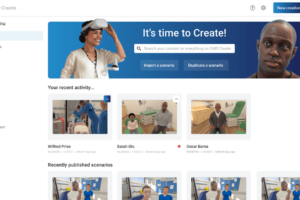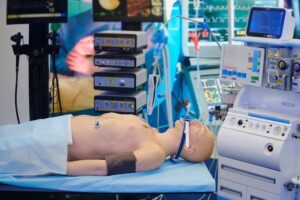How to Market a Healthcare Simulation Program
There are many factors to consider when launching a healthcare simulation program, from acquiring the necessary resources and equipment to ensuring that there are knowledgeable facilitators to provide instruction. Yet, one often overlooked element of launching a successful clinical simulation program is learning how to best market the program to potential learners. This HealthySimulation.com article provides insight on how to market a healthcare simulation program and shares a number of resources that can assist those during the planning process.
For example, ensuring that a clinical simulation program receives adequate press attention is a critical component for long-term success. This is because the public is almost completely unaware of the work medical simulation champions around the world are doing each day to improve healthcare education, training, and patient safety outcomes. This means that the more a healthcare simulation program can spread awareness, the more support and donors the program has the potential to receive. Press opportunities also help to harness other opportunities, such as increased volunteerism or partnerships.
In addition to educating the community on healthcare simulation innovations and the importance of healthcare, media attention can also demonstrate to the administration the impact of clinical simulation on learning outcomes. Further, strong marketing efforts can raise staff morale by showcasing their hard work to the community.
Sponsored Content:
When a clinical simulation program is featured in an article that is read by thousands the possibilities are endless. For example, after a local NPR article was published by the Clinical Simulation Center of Las Vegas, the local Chamber of Commerce, a local hospital, and a state assemblyman called for a tour of the healthcare simulation center. Thus, a new and permanent relationship was achieved.
Social media use by healthcare simulation program leaders or administrators is yet another way word of the program can be spread. Often clinical simulation programs will take to social media platforms such as Facebook, LinkedIn, and Twitter to share program updates, application deadlines, learner milestones, and more. Then, this online content can be shared by the program’s institution to create even more online impressions.
HealthySimulation.com Marketing Webinars
HealthySimulation.com has hosted a number of clinical simulation webinars related to the topic of healthcare simulation program marketing. By watching these webinar presentations, learners and simulationists can hear from experts across the industry who have had success in establishing medical simulation programs. The following are healthcare simulation program marketing webinars currently available on the LEARN platform.
Sponsored Content:
Successful Healthcare Simulation Leadership: Tools to Make a Difference
Presented by Paul Edward Phrampus, MD, CPE, FSSH, FACEP, CPPS, this one-hour, intermediate HealthySimulation.com webinar discusses how to be a successful leader in simulation to better position oneself and their clinical simulation program for an exciting journey into the future. Leadership in healthcare simulation requires strategy, commitment, and tools to articulate the return on investment.
Effective leadership allows for continuously created buy-in for a simulation program to promote sustainability and growth. Topics such as creating a dynamic work environment, operational models, sharing the story of a program, dealing with administration, as well as the must-have day-to-day operational tools to create success will be covered. Explore some of the scheduling, event coordination, and data tools that are crucial to long-term success. Learning objectives include:
- List three traits of effective leaders in clinical simulation.
- List three tools necessary to create a return on investment for medical simulation programs.
- List 3 strategies to engage institutional leadership in healthcare simulation.
Expand Healthcare Simulation Programs by Building Relationships
Presented by Angelia Lynn DeWeese, MSPH, CHSE, CSM, MOT, this webinar demonstrates how to move a clinical simulation program forward by building relationships with key stakeholders, administrators, and champions. Resources are invested in simulation programs and centers, and leaders anticipate and expect use, growth, and outcomes impacting patient care.
One key practice to building healthcare simulation programs is building relationships intentionally with actionable relationship-building practices reaps great rewards in clinical simulation program growth and development. In a three-year period, including COVID, DeWeese explains that her team experienced a 50% increase in learners through a simulation center. Consistent, intentional relationship-building practices were part of the successful growth strategy. Learning objectives:
- Identify the people needed to build relationships.
- Proactively meet with people identified for relationship building.
- Affirm and celebrate those with whom built relationships have been built.
How to Produce a Sim Lab Video Orientation Part I
How to Produce a Sim Lab Video Orientation Part II
Additional HealthySimulation.com Articles to Help Promote A Simulation Program
How to Produce a Sim Lab Video Orientation: HealthySimulation.com put together a two-part video series highlighting the necessary steps to producing a high-quality Simulation Lab Video Orientation. Part 1 explains the benefits of a high-fidelity simulation lab video orientation, and points out some fantastic people and places to look for support across production.
Pre-Production; How To Plan A Sim Lab Video Project: Pre-production, aka planning – will enable everyone involved with the production to determine what locations, people, and equipment are necessary ahead of time so that they can maximize efforts and reduce costs. This HealthySimulation.com provides several production tips such as the importance of defining roles and the benefits of setting deadlines.
Building a Medical Simulation Program Website: Medical simulation champions know challenging explaining what is accomplished during a healthcare simulation program is. As a new educational methodology, the integration of healthcare simulation technology is still only somewhere between “early adopter” and “early majority” on Bell’s Technology Adoption Lifecycle curve. Working in healthcare simulation can mean being responsible for educating others about clinical simulation. Thus, no matter how big or small a simulation program is, staff should communicate with higher institutional leadership about the importance of an online website.
Subscribe to our Newsletter for More Great Simulation Marketing Tips
Lance Baily, BA, EMT-B, is the Founder & CEO of HealthySimulation.com, which he started while serving as the Director of the Nevada System of Higher Education’s Clinical Simulation Center of Las Vegas back in 2010. Lance is also the Founder and acting Advisor to the Board of SimGHOSTS.org, the world’s only non-profit organization dedicated to supporting professionals operating healthcare simulation technologies. His co-edited Book: “Comprehensive Healthcare Simulation: Operations, Technology, and Innovative Practice” is cited as a key source for professional certification in the industry. Lance’s background also includes serving as a Simulation Technology Specialist for the LA Community College District, EMS fire fighting, Hollywood movie production, rescue diving, and global travel. He and his wife Abigail Baily, PhD live in Las Vegas, Nevada with their two amazing daughters.
Sponsored Content:



















